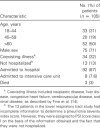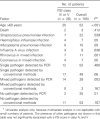Improved diagnosis of the etiology of community-acquired pneumonia with real-time polymerase chain reaction
- PMID: 16007532
- PMCID: PMC7107904
- DOI: 10.1086/431588
Improved diagnosis of the etiology of community-acquired pneumonia with real-time polymerase chain reaction
Abstract
Background: Community-acquired pneumonia (CAP) remains an important cause of morbidity and mortality. Polymerase chain reaction (PCR) has been shown to be more sensitive than current standard microbiological methods and, therefore, may improve the accuracy of microbiological diagnosis for patients with CAP.
Methods: Conventional detection techniques and multiplex real-time PCR for atypical bacteria and respiratory viruses were performed on samples collected from 105 adults enrolled in a prospective study. An infiltrate was visible on each patient's chest radiograph, and a pneumonia severity index score was determined for each patient.
Results: Microbiological diagnoses were determined for 52 (49.5%) of 105 patients by conventional techniques and for 80 (76%) of 105 patients by real-time PCR. The time to obtain the result of real-time PCR could be reduced to 6 h. PCR methodology was significantly more sensitive for the detection of atypical pathogens and viruses (P< or =.001). Respiratory viral infections and mixed infections were detected in 15 (14.2%) and 3 (2.8%) of 105 patients, respectively, by conventional methods, but were detected in 59 (56.2%) and 28 (26.5%) of 105, respectively, by real-time PCR. Presence of a mixed infection was significantly associated with severe pneumonia (P=.002). Human rhinoviruses and coronaviruses, OC43 and 229E, were frequently identified pathogens.
Conclusions: The combined real-time PCR assay is more sensitive for diagnosis of the main viruses and atypical bacteria that cause CAP compared with conventional methods, and obtains results in a clinically relevant time period.
Figures





References
-
- Guest JF, Morris A. Community-acquired pneumonia: the annual cost to the National Health Service in the UK. Eur Respir J. 1997;10:1530–4. - PubMed
-
- Guthrie R. Community-acquired lower respiratory tract infections: etiology and treatment. Chest. 2001;120:2021–34. - PubMed
-
- Murray CJ, Lopez AD. Mortality by cause for eight regions of the world: global burden of disease study. Lancet. 1997;349:1269–76. - PubMed
-
- Niederman MS. Review of treatment guidelines for community-acquired pneumonia. Am J Med. 2004;117:51–57. - PubMed
Publication types
MeSH terms
LinkOut - more resources
Full Text Sources
Other Literature Sources
Medical
Miscellaneous

